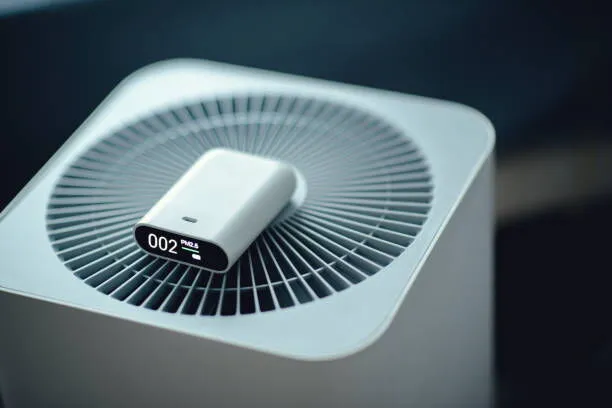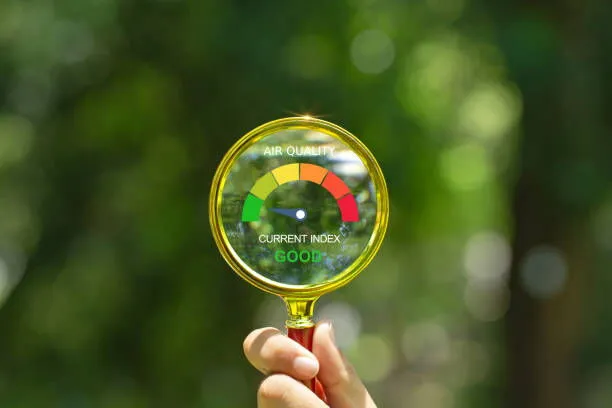On this page
With the growing awareness of environmental and health concerns, air quality has become a critical focus in modern society. Poor air quality can lead to respiratory issues, cardiovascular diseases, and long-term health risks. An essential tool in monitoring and improving air quality is the air quality sensor. These devices play a vital role in detecting pollutants, helping individuals, businesses, and governments make informed decisions to ensure healthier living and working environments. This article delves into what air quality sensors are, what they measure, how they work, and the different types available for both indoor and outdoor use.
An air quality sensor is a device designed to monitor the levels of various pollutants in the air. It detects harmful gases, particulate matter, and other environmental parameters that can affect air quality. These sensors are deployed in various settings, from homes and offices to large industrial sites and outdoor public spaces. By measuring the concentration of pollutants in the air, air quality sensors help track real-time environmental conditions and alert users to potentially hazardous air pollution levels.
As environmental regulations become stricter and more people seek to create healthy spaces, air quality sensors have become increasingly important in detecting and addressing issues related to air pollution. Air quality sensors can measure a wide array of pollutants and environmental factors that affect air quality. Here are some of the key parameters these sensors monitor: PM includes microscopic particles that are suspended in the air. These particles, often categorized by their size (PM2.5 and PM10), can penetrate the lungs and cause serious health issues, especially in people with preexisting conditions like asthma or bronchitis. VOCs are gases emitted by certain chemicals commonly found in building materials, cleaning supplies, and household products. High levels of VOCs can cause headaches, respiratory problems, and even more serious conditions over prolonged exposure. Elevated levels of CO2 in indoor environments can indicate poor ventilation, which can lead to fatigue, headaches, and decreased cognitive function. CO is a colorless, odorless gas that can be deadly in high concentrations. Monitoring CO levels is crucial for detecting potential gas leaks or inefficient combustion in appliances. Ground-level ozone, a major component of smog, can be harmful to human health. High ozone levels can irritate the lungs and worsen conditions like asthma. Often produced by vehicles and industrial activity, NO2 can exacerbate respiratory diseases and contribute to the formation of ground-level ozone. Air quality sensors may also measure temperature and humidity, as these environmental factors can influence the presence and behavior of pollutants in the air. Air quality sensors operate by detecting the presence and concentration of pollutants in the air. The sensors use different technologies depending on the pollutant they are monitoring. For example, particulate matter sensors often use laser scattering techniques to detect particles in the air, while gas sensors may use electrochemical, photoionization, or infrared methods to detect gases like CO2 or VOCs.
Once the sensor collects the data, it sends it to a monitoring system or display interface, which interprets the information and provides a clear picture of the air quality. Many modern air quality sensors are equipped with smart technology, allowing users to monitor air quality in real-time through smartphone apps or cloud-based platforms. These systems can provide alerts when air quality deteriorates, empowering users to take immediate action to improve their environment. There are two main categories of air quality sensors: indoor and outdoor. Each type is designed to address the specific air quality challenges presented by different environments. Indoor air quality sensors are designed to monitor the air in closed spaces like homes, offices, schools, and hospitals. Indoor environments often suffer from high levels of VOCs, CO2, and particulate matter due to poor ventilation, cleaning products, and the presence of electronic devices. These sensors help in maintaining a healthy indoor atmosphere by ensuring that pollutant levels remain within safe limits.

Some key features of indoor air quality sensors include: Designed to fit seamlessly into homes and offices without being intrusive. Provides instant feedback on indoor air quality to ensure healthy living conditions. Many indoor sensors can connect to home automation systems, allowing users to control ventilation systems or air purifiers based on sensor data. Outdoor air quality sensors monitor pollutants in the open environment, typically measuring pollutants like nitrogen dioxide, ozone, and particulate matter. These sensors are used in urban areas, near highways, in industrial zones, and in regions prone to pollution from vehicles, factories, and agricultural activities. Outdoor sensors are often more robust and weather-resistant than their indoor counterparts.

Key features of outdoor air quality sensors include: Built to withstand harsh weather conditions such as rain, heat, and wind.
Wide Area Monitoring: Designed to measure air quality over large outdoor spaces, providing valuable data for environmental agencies and city planners. Many outdoor sensors are part of larger networks that track air quality across regions and provide public air quality reports. Air quality sensors are crucial tools for safeguarding human health and ensuring environmental safety. Whether used in indoor settings to monitor pollutants like VOCs, CO2, and particulate matter, or installed outdoors to track harmful gases like NO2 and ozone, these sensors provide critical insights into the air we breathe. With advancing technologies and the increasing integration of sensors with smart systems, real-time air quality monitoring is more accessible than ever before.
By understanding the different types of pollutants and how air quality sensors work, individuals and organizations can take proactive steps to improve air quality, reduce health risks, and promote a cleaner, healthier future. Investing in air quality sensors is not only a measure of safety but also a commitment to well-being in the spaces we occupy daily.
As environmental regulations become stricter and more people seek to create healthy spaces, air quality sensors have become increasingly important in detecting and addressing issues related to air pollution. Air quality sensors can measure a wide array of pollutants and environmental factors that affect air quality. Here are some of the key parameters these sensors monitor: PM includes microscopic particles that are suspended in the air. These particles, often categorized by their size (PM2.5 and PM10), can penetrate the lungs and cause serious health issues, especially in people with preexisting conditions like asthma or bronchitis. VOCs are gases emitted by certain chemicals commonly found in building materials, cleaning supplies, and household products. High levels of VOCs can cause headaches, respiratory problems, and even more serious conditions over prolonged exposure. Elevated levels of CO2 in indoor environments can indicate poor ventilation, which can lead to fatigue, headaches, and decreased cognitive function. CO is a colorless, odorless gas that can be deadly in high concentrations. Monitoring CO levels is crucial for detecting potential gas leaks or inefficient combustion in appliances. Ground-level ozone, a major component of smog, can be harmful to human health. High ozone levels can irritate the lungs and worsen conditions like asthma. Often produced by vehicles and industrial activity, NO2 can exacerbate respiratory diseases and contribute to the formation of ground-level ozone. Air quality sensors may also measure temperature and humidity, as these environmental factors can influence the presence and behavior of pollutants in the air. Air quality sensors operate by detecting the presence and concentration of pollutants in the air. The sensors use different technologies depending on the pollutant they are monitoring. For example, particulate matter sensors often use laser scattering techniques to detect particles in the air, while gas sensors may use electrochemical, photoionization, or infrared methods to detect gases like CO2 or VOCs.
Once the sensor collects the data, it sends it to a monitoring system or display interface, which interprets the information and provides a clear picture of the air quality. Many modern air quality sensors are equipped with smart technology, allowing users to monitor air quality in real-time through smartphone apps or cloud-based platforms. These systems can provide alerts when air quality deteriorates, empowering users to take immediate action to improve their environment. There are two main categories of air quality sensors: indoor and outdoor. Each type is designed to address the specific air quality challenges presented by different environments. Indoor air quality sensors are designed to monitor the air in closed spaces like homes, offices, schools, and hospitals. Indoor environments often suffer from high levels of VOCs, CO2, and particulate matter due to poor ventilation, cleaning products, and the presence of electronic devices. These sensors help in maintaining a healthy indoor atmosphere by ensuring that pollutant levels remain within safe limits.

Some key features of indoor air quality sensors include: Designed to fit seamlessly into homes and offices without being intrusive. Provides instant feedback on indoor air quality to ensure healthy living conditions. Many indoor sensors can connect to home automation systems, allowing users to control ventilation systems or air purifiers based on sensor data. Outdoor air quality sensors monitor pollutants in the open environment, typically measuring pollutants like nitrogen dioxide, ozone, and particulate matter. These sensors are used in urban areas, near highways, in industrial zones, and in regions prone to pollution from vehicles, factories, and agricultural activities. Outdoor sensors are often more robust and weather-resistant than their indoor counterparts.

Key features of outdoor air quality sensors include: Built to withstand harsh weather conditions such as rain, heat, and wind.
Wide Area Monitoring: Designed to measure air quality over large outdoor spaces, providing valuable data for environmental agencies and city planners. Many outdoor sensors are part of larger networks that track air quality across regions and provide public air quality reports. Air quality sensors are crucial tools for safeguarding human health and ensuring environmental safety. Whether used in indoor settings to monitor pollutants like VOCs, CO2, and particulate matter, or installed outdoors to track harmful gases like NO2 and ozone, these sensors provide critical insights into the air we breathe. With advancing technologies and the increasing integration of sensors with smart systems, real-time air quality monitoring is more accessible than ever before.
By understanding the different types of pollutants and how air quality sensors work, individuals and organizations can take proactive steps to improve air quality, reduce health risks, and promote a cleaner, healthier future. Investing in air quality sensors is not only a measure of safety but also a commitment to well-being in the spaces we occupy daily.
Previous: Essential Insights on Total Volatile Organic Compounds (TVOC)
Next: How Does an NDIR CO2 Sensor Work?




